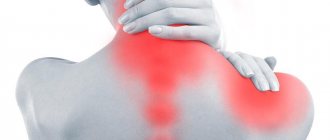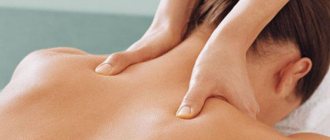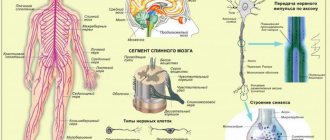From this article you will learn about the causes of dizziness with cervical osteochondrosis, its symptoms and diagnosis. Methods of treating the disease: symptomatic treatment of dizziness, how to cure osteochondrosis itself.
Author of the article: Nivelichuk Taras, head of the department of anesthesiology and intensive care, work experience 8 years. Higher education in the specialty “General Medicine”.
Article publication date: 07/11/2019
Article updated date: 01/16/2020
Dizziness is one of the symptoms of osteochondrosis of the cervical spine. This is an unpleasant sensation in a person of imaginary rotation or movement in different directions, or an illusory displacement of surrounding objects in any plane.
The causes of dizziness in cervical osteochondrosis still cause controversy among scientists and doctors. A combination of various mechanisms may be involved in its development, as well as the occurrence of headaches with osteochondrosis of the cervical spine, the main of which are:
- deterioration of blood supply to brain tissue;
- disturbances of deep (proprioceptive) sensitivity - the sensation of the position of one’s body in space.
Dizziness is a symptom of cervical osteochondrosis. When other parts of the spine are affected (thoracic, lumbar), this symptom does not occur.
The exact incidence of dizziness with cervical osteochondrosis is unknown, but some doctors believe that 20–50% of all patients suffer from this symptom.
Dizziness with osteochondrosis occurs in various people, regardless of gender. It is assumed that the risk of developing this symptom is higher if the following factors are present:
- professions associated with the impact of vibrations on the body: truck drivers, agricultural machinery workers;
- sedentary lifestyle;
- long work at the computer;
- incorrect posture;
- excessive training in the gym with a load on the shoulder girdle;
- hypothermia;
- smoking.
Symptoms of cervical osteochondrosis, including dizziness, can be either minor or so severe that they greatly impair the patient’s quality of life.
In this case, it will not be possible to completely eliminate dizziness, since for this it is necessary to cure osteochondrosis itself, which is almost impossible. However, proper comprehensive treatment – lifestyle changes, physical therapy and physiotherapy – can dramatically improve the patient’s condition.
Dizziness is not treated symptomatically with osteochondrosis. Without primary therapy, this makes no sense. The cause of dizziness needs to be removed.
Neurologists deal with the problem of osteochondrosis and all its symptoms.
Two types of dizziness: systemic and non-systemic, which occurs with cervical osteochondrosis
There are two types of dizziness:
- Systemic dizziness is the result of direct damage to the vestibular apparatus. There is a feeling of falling, tilting, swaying of the body or surrounding objects.
- Non-systemic dizziness occurs when the functioning of the nervous system is disrupted. There is a feeling of instability, it is difficult to maintain a certain posture.
With cervical osteochondrosis, a cervicogenic form occurs - a type of non-systemic dizziness, in which the transmission of impulses from the neck is disrupted and the sensation of the position of the head relative to the body changes. It occurs against the background of pain and decreased mobility in the cervical spine.
Click on photo to enlarge
What to do
Having discovered symptoms, you need to seek help from a qualified vertebroneurologist. After examining and interviewing the patient, the doctor may refer him for an X-ray or MRI.
Quickly relieve dizziness
A banana will help relieve an unpleasant symptom
If a single dizziness occurs with cervical osteochondrosis, treatment may not be necessary; it is enough to start practicing a diet.
The following instructions will help you cope with this unpleasant symptom:
- A person who feels unwell should sit down or lie down. This will help him avoid falling.
- If the head begins to feel dizzy when a person is sitting, he should place it between his knees. This helps increase blood flow to the brain.
- You can eat 1 banana or 1/2 bar of dark dark chocolate. This will help normalize blood sugar levels.
- When fainting, it is necessary to place the person in a horizontal position, tilting his head back. Having regained consciousness, the victim should take several deep breathing movements. This will help prevent a panic attack.
If everything is done correctly, the unpleasant symptom disappears after 1-2 minutes.
Physiotherapeutic procedures
How to treat dizziness with cervical osteochondrosis? If the clinical picture is not clear, the patient is referred to physiotherapy. The best procedures are listed in the table.
Table 2. Effective physiotherapeutic procedures.
| Procedure | Description |
| The procedure promotes the body's production of vitamin D. Ultraviolet light also helps absorb calcium and strengthen bone and cartilage tissue. |
| Metabolic processes accelerate, blood circulation improves. |
| The procedure promotes resuscitation of damaged tissue. |
| Low frequency current is used. Damaged areas are warmed up, blood circulation in them increases. |
Causes of dizziness
Discussions are still ongoing among scientists about whether dizziness can occur with cervical osteochondrosis, and why. Practitioners often encounter this symptom in patients with problems with the cervical spine.
Here are three theories explaining the appearance of dizziness with cervical osteochondrosis:
Deterioration of blood supply to the brain through the vertebral arteries
This is the most popular theory of the origin of vertigo. It is believed that vertebral arteries in osteochondrosis can be compressed by osteophytes (bone growths on the vertebrae) or other structures of the affected spine (herniated intervertebral disc).
This leads to a decrease in blood supply to the brain in the vertebrobasilar region. This structure includes the basilar (located at the base of the brain), vertebral artery and their branches. In such cases, compression of the vertebral arteries may increase with any movement of the neck.
Another mechanism for deteriorating blood supply to the brain is spasm of the vertebral arteries, which occurs in response to irritation of the sympathetic trunk (nerve ganglia connected by nerve fibers) located next to the spine. Spasm occurs during an inflammatory process in the nerve fibers and nodes of the sympathetic trunk.
Click on photo to enlarge
Violation of proprioceptive (deep) sensitivity - the sensation of one’s body in space
Proprioceptors are located on the skin, muscles, ligaments and joints of the human body. These are special cell structures that perceive information and transmit signals to the brain. They detect muscle contraction and ligament stretching, and perceive the position of the body in space. In the brain, the received information is processed, and the person perceives his movements adequately.
Proprioceptor dysfunction occurs when the joints of the spine become inflamed and the neck muscles spasm. Against the background of spasm and inflammation, the receptors cannot fully function. The brain does not receive the necessary information. A person does not adequately perceive the position of the neck and head in space, and dizziness occurs.
Click on photo to enlarge
Spinal cord compression
If a herniated disc occurs as a result of osteochondrosis, it can compress the spinal cord. The nerve bundles passing through it interact with the cerebellum and other centers of the brain that are responsible for the sense of balance. Therefore, when the spinal cord is compressed, dizziness may develop.
Prevention
Cervical osteochondrosis is easier to prevent than to treat, so doctors insist on carrying out powerful prevention in patients with a tendency to osteochondrosis. To avoid neck problems, you must do the following:
- to refuse from bad habits;
- give adequate physical activity;
- choose an orthopedic mattress or neck pillow, or better yet, sleep without a pillow at all;
- do therapeutic exercises;
- maintain a daily routine, alternate work and rest;
- when working sedentarily, do not forget about daily physical activity for at least 20–30 minutes;
- normalize weight if necessary.
Description of symptoms, accompanying signs
The fact that dizziness is associated with osteochondrosis is indicated by its intensification during head movements or after a long stay of the neck in one position. Dizziness caused by other causes usually occurs unrelated to changes in the position of the head and neck.
Symptoms of osteochondrosis may also be observed:
- neck pain, neck muscle stiffness;
- nausea;
- decreased sense of balance when walking or standing;
- numbness, tingling sensation and weakness in the hands;
- headache due to cervical osteochondrosis or migraine.
The duration of an attack of dizziness from cervical osteochondrosis can range from several minutes to several hours.
Symptoms may worsen after exercise, rapid movements, and keeping the neck in an abnormal position for long periods of time.
In some patients, severe dizziness significantly limits daily activities and reduces quality of life. Usually in such cases other symptoms of osteochondrosis are also expressed.
Symptoms of vertebral artery syndrome
We recommend reading:
Is elevated temperature a symptom of osteochondrosis?
Disruption of normal blood flow through the vertebral artery system inevitably gives rise to typical symptoms of the disease. In this case, in addition to dizziness, the patient complains of:
- headache of a pulsating nature, monotonous, intensifies or appears after sleeping on a high pillow, with the head thrown back, with sudden movements in the neck, localized mainly in the occipital region;
- feeling of nausea and vomiting that occurs suddenly and does not bring relief;
- various visual impairments – double vision, pain in the eyes, decreased visual acuity, intermittent appearance of a veil or fog before the eyes;
- hearing changes – decreased hearing acuity on one side, tinnitus;
- transient ischemic attacks (transient cerebrovascular accidents, in some cases can progress with the development of ischemic stroke in the vertebrobasilar artery system).
Diagnostics
There is no diagnostic method that can be used to confidently confirm or refute that a patient’s dizziness is caused by osteochondrosis.
If there is pain and dizziness, patients with these symptoms undergo a thorough examination, including a complete neurological examination, assessment of the functioning of the vestibular system and auxiliary diagnostic methods:
- X-ray of the cervical spine.
- Magnetic resonance or computed tomography (MRI, CT).
- Ultrasound examination of blood flow through the vertebral arteries.
Magnetic resonance imaging of the cervical spine
Treatment methods
Many patients at an appointment with a neurologist are interested in how to get rid of dizziness with cervical osteochondrosis.
Osteochondrosis cannot be cured, but the prognosis for dizziness caused by this disease is favorable. Most patients experience relief from symptoms with proper treatment.
The correct approach to therapy in this case is that the main measures should not be aimed at eliminating the symptom of dizziness itself, but at:
- improving blood supply to the brain through the vertebral vessels;
- treatment of changes caused by the degenerative process in the spine.
To combat this unpleasant condition, lifestyle adjustments are made, physical therapy exercises are recommended, and conservative or surgical treatment is performed.
Symptomatic treatment of dizziness is ineffective and is not used in clinical practice: it is necessary not only to relieve the symptom, but to remove its cause - this is the only way to achieve results.
Lifestyle change
Certain factors can increase the symptoms of cervical osteochondrosis, including dizziness. For example, sitting for a long time at a monitor with your neck stretched forward. You need to monitor your posture and body position while working at the computer.
How to work on a computer correctly
An important part of preventing dizziness is proper workplace ergonomics. Very often, simply moving the monitor and keyboard can significantly improve the position of your neck and upper back.
Recommendations for working on a computer:
- The eyes should be looking directly at the top third of the screen.
- Your forearms should be roughly parallel to the floor when typing on the keyboard.
- Elbows are on the sides of the body.
- Feet should be on the floor and thighs should be parallel to the floor.
If a person’s work involves rotation of the body (for example, construction, work on machines), it is necessary that these movements be symmetrical in both directions. Constantly moving the neck to one side can dramatically increase stress on certain joints and muscles, causing increased symptoms of osteochondrosis, including dizziness.
Other important changes that many patients use to get rid of dizziness caused by osteochondrosis:
- Follow the rules of a healthy diet, which provides the body with all the necessary nutrients and excludes harmful foods from the diet (fast food, chips, fried, spicy foods).
- Drinking enough water (1.5–2 liters per day) allows nutrients to reach the major organs of the body, helps eliminate harmful substances from the body, and also supports the functioning of joints and other spinal structures.
- Maintain an adequate level of physical activity.
It stimulates blood circulation and improves the flow of nutrients to all structures of the back. The movements have a positive effect on the muscles, ligaments and tendons that support the integrity of the spine. With insufficient physical activity, intervertebral discs suffer from a lack of essential nutrients, which accelerates the development of osteochondrosis and contributes to the appearance of dizziness. Do walking, swimming, cycling, gymnastics. - Do not smoke, as this can accelerate the development of osteochondrosis.
- Do not abuse alcoholic beverages. Regular alcohol consumption leads to deterioration of bone tissue and also contributes to excess weight. This increases the risk of developing back problems, including osteochondrosis.
Physiotherapy
Exercises for dizziness with cervical osteochondrosis are one of the most important parts of treating this problem.
When the muscles in the neck and upper back become weak, the head bends forward. This increases the load on the cervical spine, including facet (intervertebral) joints, intervertebral discs, muscles and ligaments, and contributes to the symptoms of osteochondrosis.
Neck exercises can relieve most of these symptoms, including dizziness. Physical therapy for osteochondrosis of the cervical spine consists of a number of exercises:
- Neck stretches: gentle turns left and right, bends forward and backward, rotations clockwise and counterclockwise. Flexibility and stretching exercises can increase or maintain mobility and elasticity in injured joints of the cervical spine, thereby relieving muscle stiffness and pain.
- Strengthening the neck muscles: touching the chin to the chest, nodding with a small amplitude, turning the head to the side, lying on the back. Exercises help maintain correct posture and relieve stress on the spine, which leads to a reduction in episodes of dizziness and other symptoms of exacerbation of osteochondrosis.
- Aerobic exercise (low-intensity exercise where oxygen becomes the main source of energy for the muscles - walking, running, swimming, skating, dancing, tennis, basketball) increases blood flow in the muscles and soft tissues of the neck, reducing their spasm and increasing mobility.
- Exercises to improve the functions of the vestibular apparatus: fixing the gaze on a slowly moving finger, walking with the head turned left and right.
Neck stretches
The most effective is an individual exercise program developed by an experienced physical therapy doctor.
Physiotherapy
Physiotherapeutic methods are used:
- transcutaneous electrical nerve stimulation;
- ultrasound therapy;
- magnetic therapy, laser therapy;
- hydrotherapy, acupuncture;
- manual therapy and massage.
Laser therapy for the cervical region
Medicines
How to treat dizziness with cervical osteochondrosis with medications? Are there drugs that quickly relieve this problem? It is impossible to completely eliminate damage to the spine. Drug therapy for osteochondrosis is not the main method of treatment - its use is justified only during periods of exacerbation.
Most often, for dizziness caused by osteochondrosis, neurologists prescribe:
- Drugs that improve blood supply to the brain or protect it from hypoxia - Actovegin, Mexidol. It should be borne in mind that the effectiveness of these drugs is doubtful among many scientists and doctors, as it has not been confirmed in studies.
- Drugs that directly reduce dizziness are cinnarizine, meclozine.
- Drugs that improve the rheological properties of blood - aspirin, pentoxifylline. They reduce blood clotting.
- Nonsteroidal anti-inflammatory drugs - ibuprofen, diclofenac, naproxen - reduce inflammation in tissues during exacerbation of osteochondrosis.
- Muscle relaxants - tizanidine, cyclobenzaprine - reduce tension in the neck muscles, thereby increasing its mobility.
- Chondroprotectors (glucosamine, chondroitin). Long-term use of these drugs can slow the progression of degeneration in the spine.
Medicines to help reduce dizziness
Folk remedies
Very often there are recipes for traditional medicine that, according to the authors, relieve cervical osteochondrosis and dizziness. The effectiveness and safety of none of them has been tested in scientific studies. If the method is chosen or applied incorrectly, these drugs can cause harm and also enter into unpredictable interactions with the medications used, so you can use various decoctions, tinctures and rubs only with the permission of the attending physician.
Recipe for balm “Deadly force”
Take 10% camphor oil (100 ml), fir oil (30 ml) and juniper oil (10 ml). Mix everything until smooth.
Apply the resulting mixture over the temples, above the eyebrows and around the ears during an attack of dizziness.
Herbal collection
- Take 1 tbsp each of meadowsweet, hawthorn, motherwort and rosehip flowers. l.
- Mix and pour boiling water (1 liter).
- Let it brew for a day.
Take 100–200 ml three times a day for 3 months.
Surgery
Surgical treatment of symptoms caused by osteochondrosis is carried out when:
- the presence of severe neurological disorders;
- failure of conservative treatment of chronic severe pain for 6 months.
It usually comes down to removing or replacing the damaged intervertebral disc with further stabilization of the cervical spine.











